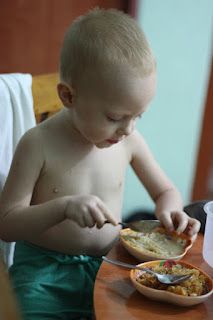This is the first year I've been in Bangladesh for the Durga Puja festival. It is the biggest of the Hindu pujas, but I've never been in the country to see what a big event it is. Now, staying with a Hindu family, I got to see the full experience.
Day 1 & 2 (সপ্তমি, অষ্টমি)
After weeks of discussing travel plans, ordering clothes, and general excitement about the upcoming puja, the first day of the puja arrived, and the festival cooking began. Below is my breakfast plate the second day: puffed rice mowas and smaller naru -- made of coconut or sesame mixed with sugarcane molasses (and delicious, a new favorite of mine). New saris, pants, shirts, shoes, ...and even a new showcase made their appearance.
Day 3 (নবমির)
This became the temple tour day. After sunset, my host family rented a CNG (CNG-powered little 3-wheeler), and we were off for the first mondop -- the tent set up for the Durga figure. At the first one, I took a few pictures and then was suprised to discover everyone was already headed back to the vehicle. After a couple more visits, the routine was clear -- everyone walked up the the mondop to do pronam (greet it) -- and then headed right back to the CNG, perhaps grabbing a snack on the way. By about midnight, we had visited 26 modops ...and spent altogether way too much time crowded into the CNG (7 passengers in a tiny vehicle designed for 3).
Day 4 (বিজয় দশমী)
On the last day, the festivity began late afternoon, with loud music and dancing around the mondops. And vermillion red was everywhere -- with people smearing it on each others' faces and clothes. Before sunset, Durja and the other images were loaded onto vangaris (flat-bed rickshaws) and taken over to the river. At the river's edge the dancing continued, even more vigorous than before (from the smell, obviously fueled by some sort of liquor). Finally after the sun set, Durga was carried down the bank and laid down in the river; and after a lot of splashing around in the shallows, was released to float downstream.

























